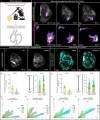Distinct mechanisms regulate ventricular and atrial chamber wall formation
- PMID: 39289341
- PMCID: PMC11408654
- DOI: 10.1038/s41467-024-52340-3
Distinct mechanisms regulate ventricular and atrial chamber wall formation
Abstract
Tissues undergo distinct morphogenetic processes to achieve similarly shaped structures. In the heart, cardiomyocytes in both the ventricle and atrium build internal structures for efficient contraction. Ventricular wall formation (trabeculation) is initiated by cardiomyocyte delamination. How cardiomyocytes build the atrial wall is poorly understood. Using longitudinal imaging in zebrafish, we found that at least 25% of the atrial cardiomyocytes elongate along the long axis of the heart. These cell shape changes result in cell intercalation and convergent thickening, leading to the formation of the internal muscle network. We tested factors important for ventricular trabeculation including Nrg/ErbB and Notch signaling and found no evidence for their role in atrial muscle network formation. Instead, our data suggest that atrial cardiomyocyte elongation is regulated by Yap, which has not been implicated in trabeculation. Altogether, these data indicate that distinct cellular and molecular mechanisms build the internal muscle structures in the atrium and ventricle.
© 2024. The Author(s).
Conflict of interest statement
The authors declare no competing interests.
Figures







References
-
- Sedmera, D., Pexieder, T., Vuillemin, M., Thompson, R. P. & Anderson, R. H. Developmental patterning of the myocardium. Anat. Rec.258, 319–337 (2000). - PubMed
-
- Wu, T.-J. et al. Role of pectinate muscle bundles in the generation and maintenance of intra-atrial reentry. Circulation Res.83, 448–462 (1998). - PubMed
-
- Ho, S. Y., Anderson, R. H. & Sánchez-Quintana, D. Gross structure of the atriums: more than an anatomic curiosity? Pacing Clin. Electrophysiol.25, 342–350 (2002). - PubMed
-
- Dobrzynski, H. et al. Computer three-dimensional reconstruction of the sinoatrial node. Circulation111, 846–854 (2005). - PubMed
Publication types
MeSH terms
Substances
Associated data
- Actions
LinkOut - more resources
Full Text Sources
Molecular Biology Databases
Research Materials
Miscellaneous

